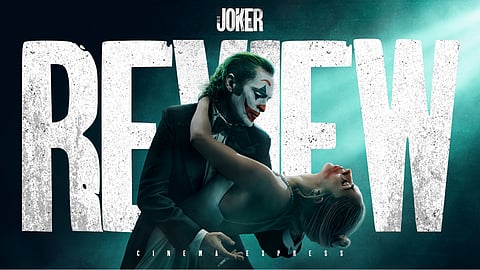Joker: Folie à Deux Movie Review: A brave, indulgent idea that isn’t easy to root for
Joker: Folie à Deux(3 / 5)
Can we truly grasp how many people live inside us—or who we could become? There are moments, as we look in the mirror—much like Arthur Fleck does—when the reflection staring back feels alien, a stranger wearing our skin. Now imagine the world glorifies that reflection, craves it. What remains of our humanity when we are no longer truly seen? Joker: Folie à Deux asks what happens when this dehumanization causes us to ‘fragment’. The big question is: what is Arthur Fleck feeling in those fractures? What’s happening in that fragmented mind?
Director: Todd Phillips
Cast: Joaquin Phoenix, Lady Gaga, Brendan Gleeson, Catherine Keener
Folie à Deux is dedicated to uncovering this, but it's not the film we might have anticipated. This isn’t criticism—merely surprise at the existential sequel that follows the grim rise of The Joker. In this film, Fleck is caught between becoming The Joker and trying to fit into the world’s expectations. We’ve all been there, rationing parts of ourselves to meet the gaze of others. But what if the world held you prisoner, reinforcing that your whole self doesn’t matter? Arthur may wear the Joker's makeup, but it’s not all he is, even if Harlene Quinzel and Gotham’s residents—and all of us—wish he were. The film’s disquieting observation: The Joker isn’t alien to us.
It’s easier to push him away though, and to cheer him on safely from a distance—like Gotham does in its morbid fascination with him. The brilliance of Phillips’ films is that they don’t fetishize The Joker. This film, in particular, is more concerned with Arthur Fleck than with the clown. Focussing on Fleck instead of the villain seems especially courageous when we have been conditioned to expect The Joker’s madness to drive the story. There’s a pivotal moment when Fleck dons the Joker’s suit, and the audience in the theatre I watched the film in, burst into applause. Yet, this isn’t a film that cares or caters to that reaction. This is where Phillips diverges from the superhero blueprint we are accustomed and addicted to. In the post-Marvel, post-Nolan era, we are almost trained to crave more action, more spectacle. But Folie à Deux defies that, delving deeper into Fleck’s internal world, even as we, not unlike Gotham’s frenzied residents, prefer the myth of The Joker to the man behind the mask.
So, no, Folie à Deux doesn’t seek to thrill you or rally comic book fans to cheer. Ironically, the first film was accused of encouraging this during its final act, but that, I think, was a reflection of audience mentality, not the film itself. This time, Phillips chooses a musical—a genre perfect for a film with such a twisted romantic soul, no? It’s about our desperate need for validation, our yearning for a companion. Arthur, who couldn’t even find politeness in others (“Nobody’s civil anymore,” from the first film), begins the movie in silence, his words caught in his throat and buried in himself. But as he falls into love, this silent man begins to sing—a voice rising from the depths of his isolation. There’s a strange beauty in that, isn’t there?
Fleck has always searched for someone to acknowledge his existence: his mother, his neighbor, Thomas Wayne, the adulation of Gotham’s masses. Now, in Joker: Folie à Deux, he finally finds someone: Harlene Quinzel, who gives him this validation, and makes him feel anything is possible. As one song goes, “I've got the world on a string, sitting on a rainbow. Got the string around my finger, what a world, what a life, I'm in love.” Love, even if detached from the real, practical version many of us may be exposed to, makes him feel free—even when trapped behind prison bars. An enduring image is of them both clinging to the prison gate, uninterested in climbing out. Each other’s company is freeing enough, you see. For Harley, though, love is the fantasy she cannot bear to lose. When fantasy is stripped away of romance, what remains?
With Folie à Deux, Phillips avoids the spectacle and instead turns inward. The film fractures not just Arthur’s mind, but also our superhero film expectations, forcing us to contemplate love, validation, and the fallout of neglect. If La La Land was a hopeful musical about dreams, this is its sad, bleak cousin—swapping dreams for nightmares, ambition for psychosis. It’s a bold idea, even if it doesn’t always offer easy satisfaction.
We already know much of Arthur’s story—his childhood, his tenuous grip on reality, his desire for approval—and so, perhaps, we don’t learn much more. The frequent musical interludes, while lovely, slow the narrative and often feel indulgent. Unlike the exhilarating dance in front of the mirror from the first film, Folie à Deux shows Arthur scrubbing off his makeup. This is a metaphor for the film itself—one that refuses to deliver the spectacle we crave, instead scrubbing the layers off this man, trying to lay bare his mind and pain for us to understand.
Still, questions linger. Why isn’t Harlene Quinzel written with more depth? Why do some of the songs feel so indulgent? Why does the film almost seem to taunt the Marvel-trained viewer to abandon ship? In both films, Arthur Fleck runs—a strange, wide-stepped dash—as though he’s fleeing from himself, his past, even his shadow, as captured in the opening sequence. And perhaps, in the end, Folie à Deux holds up a mirror to us as well, daring us to answer why we are so disappointed when this broken man doesn’t turn into the entertaining character we wanted him to be. After all, as another song goes in the film, “The clown with his pants falling down… that’s entertainment.” What when we don't get that?


